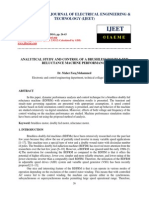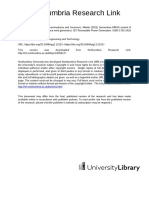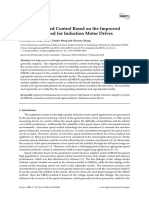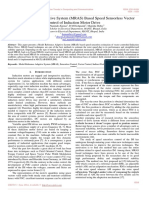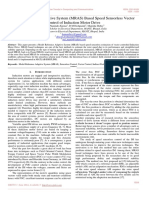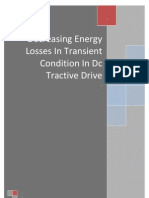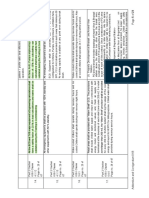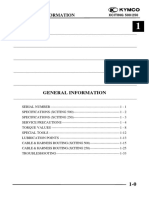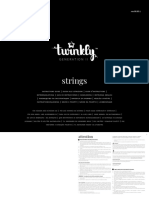IET Power Electronics
Research Article
Implementation of reactive power-based ISSN 1755-4535
Received on 12th February 2017
Revised 18th August 2017
MRAS for sensorless speed control of Accepted on 7th September 2017
E-First on 13th November 2017
brushless doubly fed reluctance motor drive doi: 10.1049/iet-pel.2017.0104
www.ietdl.org
Karuna Kiran1, Sukanta Das1
1Department of Electrical Engineering, Indian Institute of Technology (Indian School of Mines), Dhanbad, India
E-mail: asksukanta@rediffmail.com
Abstract: The present work introduces the concept of classical reactive power (Q)-based model reference adaptive system
(MRAS) for the speed estimation and control of low-cost BDFR motor drive. The reasons behind such choice for this drive's
control are: (i) MRAS-based controllers can inherently take care of the machine parameter variations which had been a
challenging issue with the other available sensorless speed estimation strategies and (ii) the employment of Q as a functional
candidate inevitably makes the formulation immune to the variations in stator resistance. The experimental assessment, in this
respect, confirms these claims. Furthermore, the analytical validation of Popov's hyperstability criteria on the proposed
controller, confirms the drive's overall stability within the investigated speed control range. The speed control performance is
examined in MATLAB/Simulink. The simulation results are further validated by a real-time implementation using dSPACE-1103-
based 1.6 kW BDFR machine prototype.
Nomenclature A detailed comparative study between BDFIM and BDFRM is
available in [6].
ipd, ipq, isd, isq d–q primary and secondary currents (A) The stator of BDFRM consists of two electrically and
vpd, vpq, vsd, vsq d–q primary and secondary voltages (V) magnetically isolated three-phase windings: primary and
λpd, λpq, λsd, λsq d–q primary and secondary winding fluxes secondary. The electromagnetic (EM) torque production in the
(Wb) machine depends on the magnetic coupling between the windings
Rp, Rs primary and secondary winding resistances through a position-dependent highly salient cageless reluctance
(Ω) rotor with its number of poles equal to the total number of stator
Lp, Ls primary and secondary winding self- pole pairs [7, 8]. The primary winding of BDFRM is usually fed
inductances (H) from the grid, whereas the secondary winding is powered by a
λps, Lps mutual flux (Wb) and inductance (H) fractionally rated variable-voltage-variable-frequency converter for
T e, T l electromagnetic and load torque (Nm) bi-directional power flow between the grid and the machine under
pr, pp, ps number of rotor poles, primary and secondary subsynchronous, synchronous and supersynchronous speeds [3, 9,
pole pairs 10].
ωp, ωs primary and secondary supply angular Various methodologies such as scalar control [3, 11], vector or
frequencies (rad/s) field-oriented control (VC/FOC) [3, 9–12], direct torque (DTC)
ωr, ωrm rotor electrical and mechanical angular speed and secondary flux [11, 13] or primary reactive power [14, 15]
(rad/s). Herein after denoted as speed (rad/s) control, direct power control [16] and variable structure control [2]
σ = 1 − Lps2
/(LpLs) leakage factor have been addressed in the literature to achieve different control
ε error signal objectives of BDFRM-based drives. A comparative and
∙ time derivative operation progressive work with respect to these control strategies is also
θr, θp, θs rotor, primary and secondary reference frame available in [11, 12]. However, the execution of these closed-loop
positions controls relies on the rotor position/speed feedback. Moreover, a
limited number of research efforts are put forward for the
sensorless speed control of such drives [11–13, 17]. Except for a
Subscripts
very recent work based on sensorless FOC of BDFRM [12], the
A, B, C/a, b, c primary/secondary-phase quantities remaining works are primarily concerned with the DTC-based
strategies. In addition, model reference adaptive system (MRAS)-
Superscripts based control techniques have been overlooked yet for this
machine. The MRAS-based approaches are simple in formulation
r/s rotating and stationary reference frame quantity and implementation; and inherently take the machine parameter
*, ^ reference/command and estimated quantities variations into account with minimum computational effort [18].
Since, MRAS-based control techniques have been used
1 Introduction satisfactorily in the other AC drives, these techniques are also
resourceful for BDFRM drive as well. Depending on the functional
In recent years, brushless doubly fed reluctance machines candidate used for the formulation of the error, a number of
(BDFRMs) have shown better suitability for the applications such MRASs based on either rotor flux [19, 20] or back electromotive
as wind power generation [1, 2] and pump-type appliances [3, 4] to force [21] or reactive power [22–24] or active power or EM torque
meet narrow variable speed requirement. Greater robustness, [25] or V ∗ × I [26] are developed for induction machines (IMs). A
simple but efficient speed control strategies, lower capital detailed review of different MRAS-based controllers for IM drive
investment and maintenance cost than the other slip-power is presented in [27].
recovery machines [5] [such as BDF inductance machines Hence, the present work intends to introduce the MRAS-based
(BDFIMs)] are the major grounds behind their growing popularity. new approach for sensorless speed control of BDRFM (as motor)
IET Power Electron., 2018, Vol. 11 Iss. 1, pp. 192-201 192
© The Institution of Engineering and Technology 2017





















